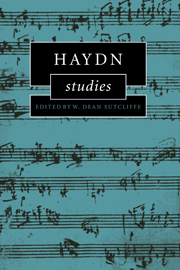Book contents
- Frontmatter
- Contents
- Preface
- Editor's note
- 1 The consequences of presumed innocence: the nineteenth-century reception of Joseph Haydn
- 2 Haydn's sacred vocal music and the aesthetics of salvation
- 3 Sentiment and sensibility in La vera costanza
- 4 Haydn as Romantic: a chemical experiment with instrumental music
- 5 Haydn's ‘Cours complet de la composition’ and the Sturm und Drang
- 6 Haydn's reversals: style change, gesture and the implication-realization model
- 7 Haydn's symphonies between Sturm und Drang and ‘Classical style’: art and entertainment
- 8 The Haydn piano trio: textual facts and textural principles
- 9 Papa Doc's recap caper: Haydn and temporal dyslexia
- 10 Haydn: the musicians' musician
- Index
6 - Haydn's reversals: style change, gesture and the implication-realization model
Published online by Cambridge University Press: 22 September 2009
- Frontmatter
- Contents
- Preface
- Editor's note
- 1 The consequences of presumed innocence: the nineteenth-century reception of Joseph Haydn
- 2 Haydn's sacred vocal music and the aesthetics of salvation
- 3 Sentiment and sensibility in La vera costanza
- 4 Haydn as Romantic: a chemical experiment with instrumental music
- 5 Haydn's ‘Cours complet de la composition’ and the Sturm und Drang
- 6 Haydn's reversals: style change, gesture and the implication-realization model
- 7 Haydn's symphonies between Sturm und Drang and ‘Classical style’: art and entertainment
- 8 The Haydn piano trio: textual facts and textural principles
- 9 Papa Doc's recap caper: Haydn and temporal dyslexia
- 10 Haydn: the musicians' musician
- Index
Summary
How would the Western musical canon look to an outsider? Bruno Nettl, the doyen of American ethnomusicologists, reports the following experience:
Carnatic musicians in Madras, looking interestedly at the foreign musical culture of the West, said to me, ‘We have our trinity of great composers, Sri Tyagaraja, Syama Sastri, and Muttuswami Dikshitar, just as you have your trinity,’ meaning Haydn, Mozart and Beethoven. But I would like to argue that dualism is a more significant guide to the conceptual framework of the Music Building and its cultural context. Mozart and Beethoven are presented as emblems of the two ends of a continuum not only by the myth-makers; they have been so recognized by musicologists for a long time.
Nettl's encounter rings true: our conceptual framework really does appear to have a blind spot for the master of Eszterháza. Why is this so? Special pleading, the watchword of Haydn studies, seems to address both scholars and listeners at cross-purposes to their needs, alternately preaching to the converted and lecturing to deaf ears. The defensive, frankly partisan, tone which permeates books such as Haydn's ‘Farewell’ Symphony is directed not to the merits of the composer, about which there is not a particle of doubt, but to the extraordinary gap between our critical encomiums and his historiographical neglect. Haydn, in short, is a victim of the way we construct historical narrative, a composer squeezed between his brother giants, Mozart and Beethoven.
- Type
- Chapter
- Information
- Haydn Studies , pp. 177 - 217Publisher: Cambridge University PressPrint publication year: 1998
- 10
- Cited by



